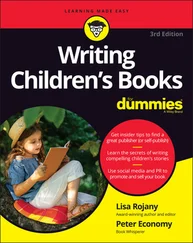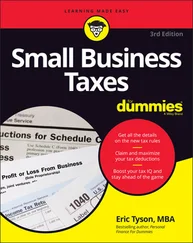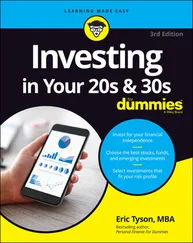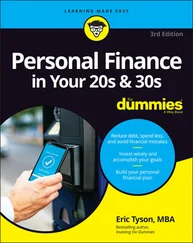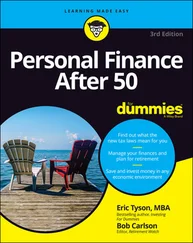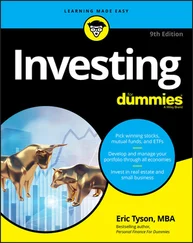The performance economy model calls for a shift from offering products to offering Products as a Service (PaaS). The idea is that, rather than buy a product you'll eventually throw away, you buy the service that the product provides. Rather than buy disposable lightbulbs, for example, you would buy the service of lighting.
The result is a push toward reuse and remanufacturing, which is less labor-, resource-, and capital-intensive than producing new products all the time. It shifts the paradigm from “products have value” to “products provide a service that’s valuable.”
Walter Stahel, who wrote the book The Performance Economy in 2006, offers a new business model that’s driven by values, gains knowledge and insight into its customers, and relies on circular systems based on biology.
The blue economy systems approach
Proposed in 2009 by the former CEO of Belgian cleaning product company Ecover, Gunter Pauli, the blue economy approach takes advantage of the rise of the open-source movement. Based on a set of 21 principles, the blue economy stresses business solutions determined by their local environment that could potentially create “100 innovations that can create 100 million jobs within the next 10 years.”
For more on the blue economy approach, see www.gunterpauli.com .
The concept of a circular economy offers a way to overcome the wasteful, energy-and-resource-intensive approach of the last 200 years. The strain of keeping up with the take-make-waste system is starting to be felt, driving companies to start measuring, tracking, and reducing their impacts in meaningful ways.
As the trends, economic indicators, and investments are showing, interest in the circular economy is on the upswing, and companies can capture some valuable benefits by choosing this approach.
The financial, health, compliance, and sustainability drivers will carry the world to a bright circular future.
Shar Olivier, senior sustainability consultant at Vessel, an environmental services and clean energy consultancy group based in New York, has the following to say about developing a circular economy strategy:
Strategy in the circular economy creates closed loops. Currently, our economy and industry use a take-and-make linear model. Raw materials are mined and used as products and then thrown away. Waste, pollution, and resource scarcity are hallmarks of this linear model. In the circular economy, most materials enter back into either the biological or technical streams. In our work, we strive to create design thinking for the circular economy model. We use data, lifecycle assessment, and design thinking to create solutions through products and services that foster a closed loop, zero-waste strategy.
Over a decade ago, we started a disposable paper product company called Full Circle. We used post-industrial waste (sugar cane husk fibers) that were headed for the landfill or incinerator as our material. We took the ground-up fibers (also known as bagasse) and shaped them into plates and cups that could then be composted after use. We saved the material from ending up in a landfill or, worse, being burned and releasing greenhouse gases, furthering climate change. That material then became our product. By creating a zero-waste production plan, we prevented pollution and created a viable product that could then be returned to the biological stream through composting. We created an everyday product like paper plates, but instead of using virgin forest trees as fibers, we took the stalks from sugar cane, used to make sugar, and reused the spent fibers to make useful products that would then be composted. We closed the loop!
Petroleum-based plastic is an enemy of the circular economy. Only 2 percent of plastic sent to be recycled actually gets recycled. Single-use petroleum plastics clog our waterways and, by 2030, it is estimated that there will be more plastic than fish in our oceans! As part of the solution strategy for plastic, we designed disposable, compostable, plant-based plastic cutlery from vegetable starch. Potatoes and other plants that contain high levels of starch provide excellent binders needed to create sturdy, plant-based plastic cutlery. After use, instead of ending up in a landfill, our forks and spoons can be safely composted. These bionutrients go back into the stream and we closed the loop.
Another terrific example of transition strategy to the circular economy model is when a large. US-based household company that produces detergents and other solvents brands has thousands of tons of waste detergent annually, due to specs not being met for human use. The make-and-take-then-dispose linear model dictates that this soap (hundreds of thousands of tons of it!) be sent to a landfill each year. This company’s sustainable strategy team decided to cull it from the waste stream and sell it to car washes. This created millions of dollars in a new revenue stream while saving hundreds of tons of waste from the landfill. They closed the loop!
Recycling, reuse, and zero-waste streams are at the core of the circular economy model. In our consulting with large companies, universities, and government agencies, we strive to create strategies, policies, and production processes that realize our natural resources are finite. We cannot afford to use up and throw away petroleum, forests, precious metals and other resources that then create pollution, contaminate water and air, and become hazardous to wildlife and biodiversity. When we understand and embrace the circular economy strategy, scarcity, deforestation, pollution, and waste become problems of the past.
Chapter 4
From Linear To Circular: What You Need To Know
IN THIS CHAPTER
 Understanding the key differences between a linear and circular economy
Understanding the key differences between a linear and circular economy
 Identifying how waste from one system can become a resource for another
Identifying how waste from one system can become a resource for another
 Investigating how resilience influences the circular economy
Investigating how resilience influences the circular economy
When scientists drop the scary-sounding term entropy into a conversation, all they’re doing is describing the amount of waste or disorder in a system. Even within the most efficient circular systems — like the ones this book is focused on — waste and disorder will exist. And it has to exist, because waste is a vital component of the second law of thermodynamics. If you paid attention in physics class, you’ll remember that this second law addresses the irreversibility of natural processes and the limitation of efficiency. Does it ring a bell? No? Okay, well, for those of you who passed notes during physics class, the idea here is that there's a limit to how efficiently energy can be transferred between systems — waste will always exist, most commonly as heat loss. This is why neither a fully circular economy nor a perpetual motion device will ever exist. Wait — you might believe that this statement massively contradicts the intentions of this book, but we promise you, you would be wrong.
Most people grow up believing that waste is just something that goes “away,” right? You put your white, plastic trash bag in the garbage can and some big, diesel-powered truck magically removes it from your life to a faraway land. But that’s the wrong way to look at waste, and, honestly, that perspective is responsible for why the world is in the pickle it’s in today. Waste — or the energy that will inevitably leave a system — doesn’t need to be piled a mile high in a landfill. It doesn’t even need to go away. We’re wasting precious resources every time it does go away. If we humans redefine what waste means to us, acknowledge that it doesn’t need to exist, and redirect it based on how energy flows occur in nature — as food for another system— we can eliminate pollution and the natural tendencies of entropy.
Читать дальше
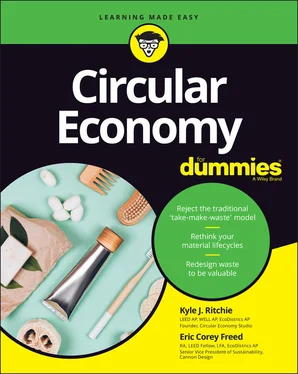
 Understanding the key differences between a linear and circular economy
Understanding the key differences between a linear and circular economy
